![]() We've already talked about it in this blog: Yoctopuce has been trying to make a (good) RFID reader for literally years. A project which, until now, has never materialized due to the lack of a good-quality radio module that doesn't cost an arm. But this time, we think we've found it, and Yoctopuce is finally marketing an RFID reader. Let's see have a look at it...
We've already talked about it in this blog: Yoctopuce has been trying to make a (good) RFID reader for literally years. A project which, until now, has never materialized due to the lack of a good-quality radio module that doesn't cost an arm. But this time, we think we've found it, and Yoctopuce is finally marketing an RFID reader. Let's see have a look at it...
Presentation
The Yocto-RFID-15693 comes in the form of a 60x58mm board, and is based on Metratec's Dwarf15 module. It can work with ISO-15693 RFID tags. It is capable of detecting several tags at a time, as well as reading and writing data in the memory of detected tags.
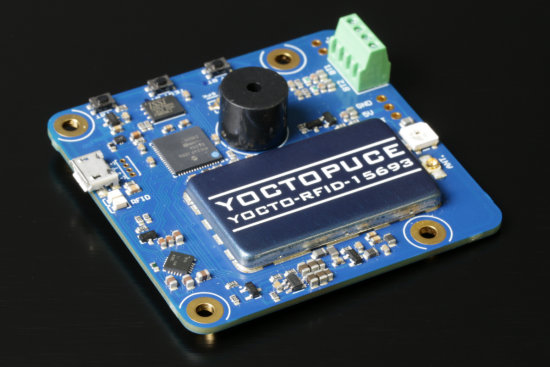
The new Yocto-RFID-15693.
In addition to its RFID functionality, Yocto-RFID-15693 offers a small buzzer, two anButton inputs for connecting buttons, potentiometers or other resistive sensors. Finally, it has a built-in RGB LED, with the option of adding more. It's even possible to deport the buzzer functionality by connecting an external loudspeaker. In short, you've got everything you need to provide good feedback when someone presents a tag in front of the reader.
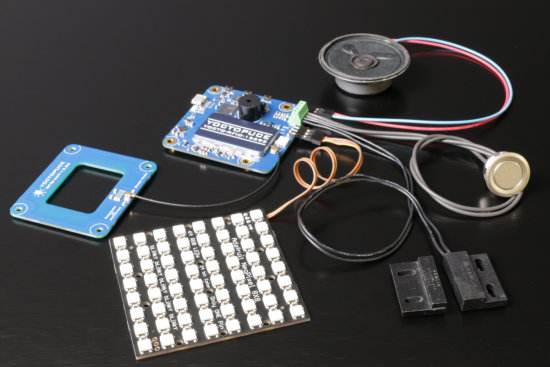
On can connect many accessories to the Yocto-RFID-15693
About the antenna
We chose to make a module without an integrated antenna because it offers more freedom in terms of installation. That's why the Yocto-RFID-15693 has a UFL antenna connector. Please note that, although essential, this antenna is NOT supplied with the module; you'll need to purchase it separately. You can choose the RFID-Ant-13.56 model, manufactured by Yoctopuce, but you can also use antennas supplied by other vendors. Some alternative models are listed in the Yocto-RFID-15693 user manual.
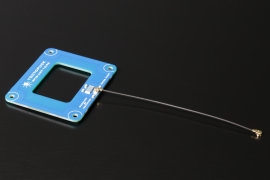
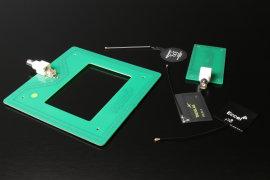
You can use the Yoctopuce antenna or competing models
We've chosen to sell the antenna separately because the geometry of an RFID antenna has an influence on the reader's performance, typically the detection distance and the number of tags that can be detected simultaneously. That being said, the Yoctopuce antenna has a number of advantages: it has been designed to enable the creation of a very compact reader + antenna system, thanks to its format compatible with double-width modules.
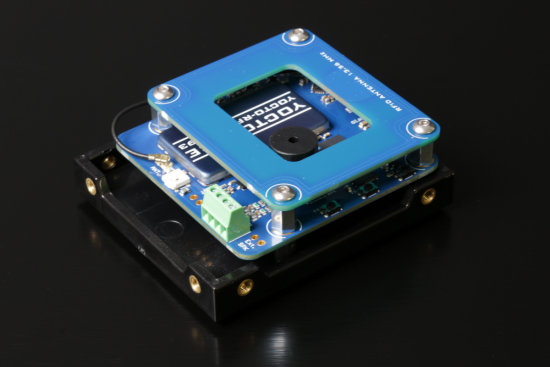
The Yoctopuce antenna can be affixed on the reader
Note that, by means of adapters and a coaxial cable, the antenna can be deported to considerable distances. Out of curiosity, we tested with the longest cable we had on hand. Imagine our amazement when we realized that it still worked with an 80m cable between the Yocto-RFID-15693 and the antenna.
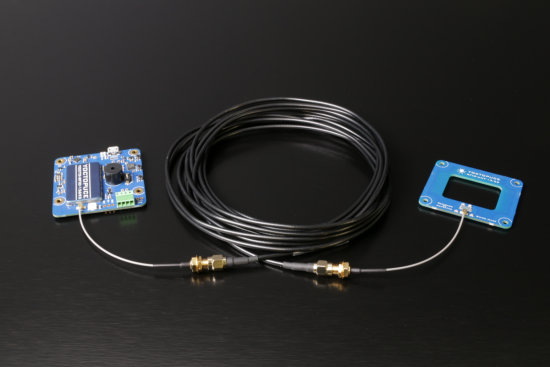
The antenna can be deported quite far away.
The tags
RFID tags come in a multitude of forms: credit cards, self-adhesive labels, tokens, washers, key rings and so on. Choose the one best suited to your application, but bear in mind that the smaller the tag, the shorter the detection distance, and the larger the tag, the fewer can be physically presented in front of the antenna at the same time. When you buy your own, make sure they're ISO-15693-compliant, otherwise the Yocto-RFID-15693 won't detect them.
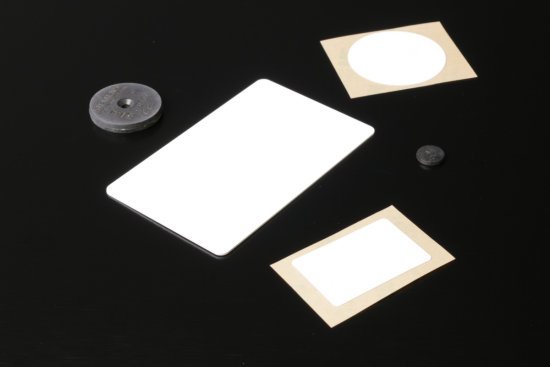
RFID tags are available in many form factors
The Yocto-RFID-15693 comes with a credit-card-sized ICODE DNA tag, so you can play with the reader right out of the box (if you've thought about buying an antenna). Yoctopuce doesn't really intend to become a RFID tags distributor, but if you need extra cards, we've decided to sell packs of 10 under the reference ICODE-DNA-CR80x10. This will save you from having to order huge quantities from better-stocked vendors clearly aimed at professional customers.
The API
Particular attention has been paid to the Yocto-RFID-15693 's API, so that anyone can benefit from easy access to RFID technology. The memory of most RFID tags is organized in blocks. The size and number of these blocks varies from one tag model to another. Some of these blocks may contain tag configuration data, and must not be overwritten, otherwise the tag will become unusable. Each block can be accessed independently, but must be written to and read from in its entirety. In short, reading or writing to an RFID tag usually requires a good knowledge of the tag's architecture. With the Yoctopuce API, you can simply write data blobs of arbitrary size, starting from the block of your choice, and the module will take care of converting it into a sequence of blocks of adequate size. If you try to overwrite a special block, or try to write more data than is possible, it will warn you. Here's a small example in Python.
cards. Such cards can normally be read out by a
reader without being powered themselves, as the
reader will supply the necessary power to the
card over the air (Wikipedia) """
reader = YRfidReader.FirstRfidReader()
tagID = "E0080145250446B5"
status = YRfidStatus() # will contain RFID error description.
options = YRfidOptions() # standard options
if (reader.tagWriteStr(tagID, 1, data, options, status)!=YAPI.SUCCESS):
print("write failed: "+status.get_errorMessage())
Of course, you can always disable the various protections using the options parameter, allowing you to manage special blocks yourself. The API also offers other advantages, such as the ability to install a callback that will be called every time a tag is presented or leaves. You'll find more details in the user manual.
Limitations
Like all Yoctopuce products, the Yocto-RFID-15693 isn't magic, and is subject to a few limitations of which you should be aware.
- The average detection distance of tags is around 10-15cm, but this may vary according to antenna geometry and the tags used. You may have noticed that some RFID tags are proudly advertised as being detectable up to 1.5m, but without mentioning this presupposes that the reader is powerful enough to reach such distances, which is not the case with the Yocto-RFID-15693.
- The Yocto-RFID-15693 works with ISO-15693 tags, which are widely used in the industrial world.
- It will not work with Mifare tags, better known to the general public, but which are ISO-14443A standard .
Conclusion
We've put a lot of work into the Yocto-RFID-15693, and hope it lives up to your expectations. We realize that many of you would probably prefer to work with Mifare tags, but Metratec's Dwarf14 is NRND. However, Yoctopuce may decide to make an ISO-14443A-compatible reader if Metratec releases a successor to the Dwarf14.


